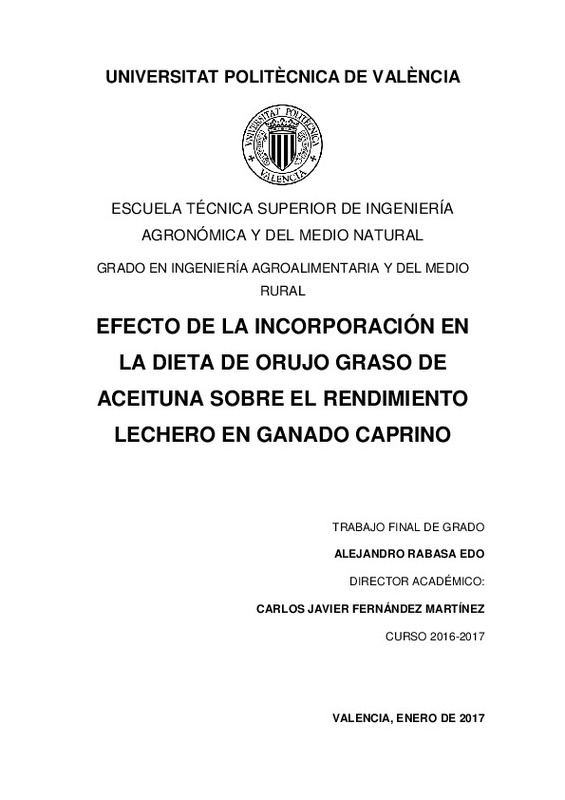|
Resumen:
|
[ES] La alimentación supone un coste muy elevado en las explotaciones de ganado caprino
en condiciones intensivas. El empleo de subproductos permite aumentar la
disponibilidad de fuentes de alimentos y reducir costes.
En ...[+]
[ES] La alimentación supone un coste muy elevado en las explotaciones de ganado caprino
en condiciones intensivas. El empleo de subproductos permite aumentar la
disponibilidad de fuentes de alimentos y reducir costes.
En el presente trabajo se utilizaron 14 cabras hembras lactantes de raza MurcianoGranadina
de la Granja Experimental del Departamento de Ciencia animal de la
Universitat Politècnica de València, con un peso medio de 38,45 ± 0,75 kg. Se
separaron en dos grupos homogéneos en cuanto a producción y peso y a cada grupo
se le suministró una dieta diferente, el grupo Control con un pienso compuesto con
mayor proporción de cebada y el grupo Orujo con un pienso al que se incorporó orujo
graso de aceituna. Para ambos grupos el forraje fue alfalfa granulada. La proporción
forraje:concentrado fue de 40:60.
Las pruebas realizadas permitieron estudiar el efecto de la incorporación en la ración
de cabras lecheras del orujo graso de aceituna sobre la ingestión, la digestibilidad, el
balance energético, el rendimiento lechero y la producción de metano. Los datos
obtenidos se analizaron estadísticamente para observar con claridad las posibles
diferencias significativas que pudieran existir entre los efectos estudiados de cada una
de las dietas.
En cuanto a la ingestión de materia seca, fue baja para ambas dietas sin resultar
estadísticamente significativa. Debido a esta baja ingestión, las cabras de ambos
grupos movilizaron reservas corporales para mantener el rendimiento lechero, en el
que no se observaron prácticamente diferencias. La digestibilidad fue superior en la
dieta control, debido al mayor consumo de pienso por parte de los animales de este
grupo. Se observaron diferencias para los gramos de metano producidos al día,
resultando así por el mayor consumo de fibra por parte de los animales del grupo
Orujo.
A nivel experimental, es esencial cuantificar el consumo o rechazo del ingrediente
problema, del que habría que mejorar los aspectos relacionados con la apetecibilidad,
así como controlar la calidad de la grasa que contiene y su estado de conservación
para evitar que se enrancie.
[-]
[EN] Feeding is a very high cost for goat farms under intensive conditions. The use of byproducts
increases the availability of food sources and reduces costs.
In the present work, 14 lactating female goats from the ...[+]
[EN] Feeding is a very high cost for goat farms under intensive conditions. The use of byproducts
increases the availability of food sources and reduces costs.
In the present work, 14 lactating female goats from the Murciano-Granadina race of
the Experimental Farm of the Department of Animal Science of the Universitat
Politècnica de València were used, with an average weight of 38.45 ± 0.75 kg. They
were separated into two homogeneous groups in terms of production and weight and
each group was given a different diet, the Control group with a compound feed with a
higher proportion of barley and the Orujo group with a feed containing olive oil. For
both groups the forage was granulated alfalfa. The forage: concentrate ratio was
40:60.
The tests allowed the study of the effect of the incorporation in the diet of dairy goats
of olive pomace on ingestion, digestibility, energy balance, milk yield and methane
production. The data obtained were statistically analyzed to clearly observe the
possible significant differences that might exist between the studied effects of each of
the diets.
As for the dry matter intake, it was low for both diets without being statistically
significant. Due to this low ingestion, the goats of both groups mobilized body reserves
to maintain milk yield, in which practically no differences were observed. The
digestibility was higher in the Control diet, due to the higher consumption of feed by
the animals of this group. Differences were observed for the grams of methane
produced per day, resulting in the higher consumption of fiber by the animals of the
Orujo group.
At the experimental level, it is essential to quantify the consumption or rejection of the
problem ingredient, which would have to improve the aspects related to appetite, as
well as to control the quality of the fat contained in it and its state of conservation to
avoid it becomes rancid.
[-]
|







